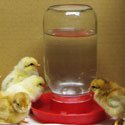
Baby chicks must have access to clean, fresh water at all times. During the first few days after they hatch, a one-quart waterer will furnish enough water for up to 25 chicks raised in a brooder.
An inexpensive watering option is a screw-on plastic base that fits a one-quart narrow mouth jar. Another option is an all-plastic one-quarter waterer that comes with a screw-on base.
Don’t be tempted to cut corners by furnishing water in an open dish or saucer. Chicks will walk in it, filling the dish with bedding and droppings that spread disease. They’ll be more likely to get wet and chilled. And some chicks may drown.
Drowning is generally not an issue when chicks have a properly designed waterer, unless they are so tight for brooder space that they can’t spread out to sleep without some chicks being crowded into the water. For smaller birds — such as tiny bantams, guinea keets, quail, and pheasants — you might put marbles or clean gravel in the base for the first few days until the birds grow big enough not to fall into the water. Or you could opt to use a drown-proof game chick waterer base.
During the first days of brooding, place the waterer on a sturdy flat surface, such as a small square of plywood or a large ceramic tile. The purpose of this platform is to steady the base to reduce the chance that the waterer will tip and leak. A platform also helps keep brooder litter out of the drinking water.
Within a week or two, the chicks will outgrow the one-quart waterer. You’ll know the time has come when you find yourself filling the waterer increasingly more often to make sure your chicks always have water. The time for changing to a larger waterer has long since passed if you find the quart jar overturned and spilled due to the boisterous play of growing chicks.
A one-gallon waterer not only furnishes more water, but also has a wider base and therefore is less easily knocked over. A one-gallon waterer may be used until the chicks are about a month old, at which time you’ll need to explore other options, such as a larger capacity waterer, or a Brite Tap nipple system. Whenever you change to a different waterer, leave the old one in place until all the chicks get used to drinking from the new one.
As your chicks grow, adjust the waterer to keep the water level at the correct height. The water level should be between a chick’s eye and the top of its back. When the water is at this height, birds drink more and spill less. Ensuring that your chicks always have an adequate and accessible supply of clean, fresh water goes a long way toward keeping them healthy and growing well.
And that’s today’s news from the Cackle Coop.
Gail Damerow, author, Hatching and Brooding Your Own Chicks (Chickens, Turkeys, Ducks, Geese, Guinea Fowl)


I am really impressed that you put together good and useful information on chicken watering system.
Thanks,Keep sharing.